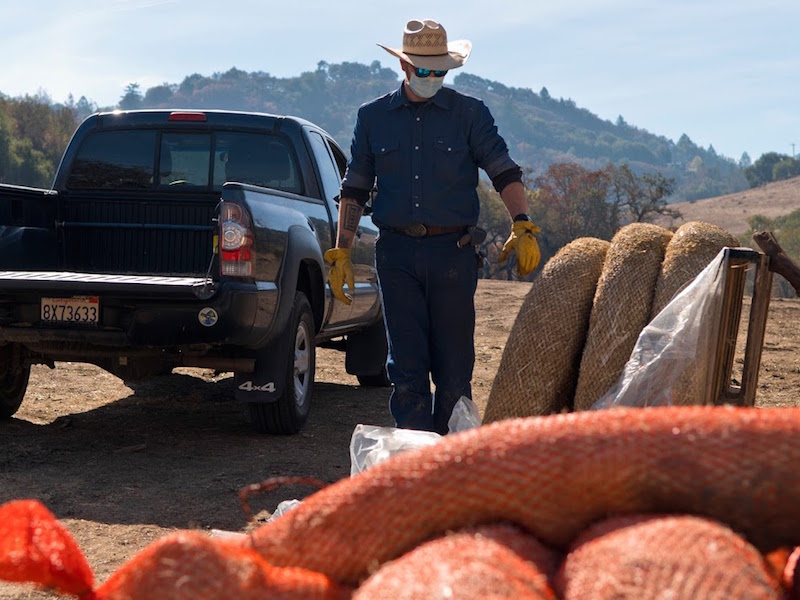As the season’s first rains begin to fall, and with dozens of burned structures left behind by the Glass fire, Sonoma Ecology Center has hit the ground running—or more precisely, wattling.
With the relaunch of our Watershed Protection Program—designed to shore up the toxic ash and debris still remaining at burned sites before it is washed into nearby waterways—Sonoma Ecology Center staff members are reaching out to landowners and others in the Sonoma Valley, Santa Rosa and Mark West watersheds and leading work at burned sites in order to ensure that local waterways stay clean and clear when heavy rains arrive.
Besides extensive toxics-containment work on burned landscapes by SEC’s Restoration experts, our quick response has included two Toxic Runoff Containment Workshops in Mark West, where we gave away stacks of wattles—those straw-filled fabric tubes draped across landscapes to contain runoff—to property owners free of charge, along with stakes to secure them and in-person instruction on how to place them properly. The events were so well-received that two more have been scheduled for this Friday, Nov. 20 and Monday, Nov. 23.
The ash and debris of burned man-made structures is laced with toxins such as heavy metals, asbestos and nitrates, and is a potential source of pollution should those toxins end up in nearby streams. To prevent that from happening, local communities are mobilizing to surround burned sites with wattles, sandbags and similar materials, shoring them up and keeping toxins in place until they can be disposed of. Some areas were harder hit than others, and a higher priority is given to sites on steep slopes or close to waterways, which pose a greater threat.
Therefore, as explained in a recent Santa Rosa Press Democrat story, “The county is sponsoring several community groups to team up with neighborhood associations and landowners to ensure that high-risk areas receive attention. … contracting with the Russian Riverkeeper, the Community Soil Foundation and the Sonoma Ecology Center.”
Here’s a short video from that story of Bruce Hall, a fire recovery project manager for Sonoma Ecology Center, demonstrating good wattle placement at one of the workshops:
“It is our hope to continue to assist the community to contain potentially harmful fire runoff and prevent it from moving throughout the watershed,” said SEC’s Wendy Hayes, a lead organizer of the Watershed Protection Program, in a message to Mark West residents.
Hayes noted that recent rains have actually given landowners more time, not less, to tackle the problem of toxic runoff from burned structures.
“Luckily the first rains of the season have been gentle, which generally helps to stabilize sediment (instead of heavy rains which disperse and mobilize materials quickly),” Hayes said. “This is good news and gives us all more time.”
Lynn Garric, a Mark West resident who hosted and helped organize the previous wattles workshops, and will do so again this Friday and Monday, said the events already have been “a tremendous success.”
“The community was excited about doing their part to protect the creeks,” she said. “Everything, from the signage, handouts, reception, demonstration and loading up was super-organized and helpful, and I know everyone appreciated SEC’s leadership.”
She added, “In addition to helping watershed conservation, today’s event was a healing opportunity for neighbors to see each other, to feel like they were doing something meaningful, and to help each other. That was a double success.”
Healing communities, and the land, is what Sonoma Ecology Center’s Watershed Protection Program is all about. For more on the program and what community members can do to give or receive help, visit the Watershed Protection page or email firerecovery@sonomaecologycenter.org. For general information on fire recovery, see our Fire Recovery page.

